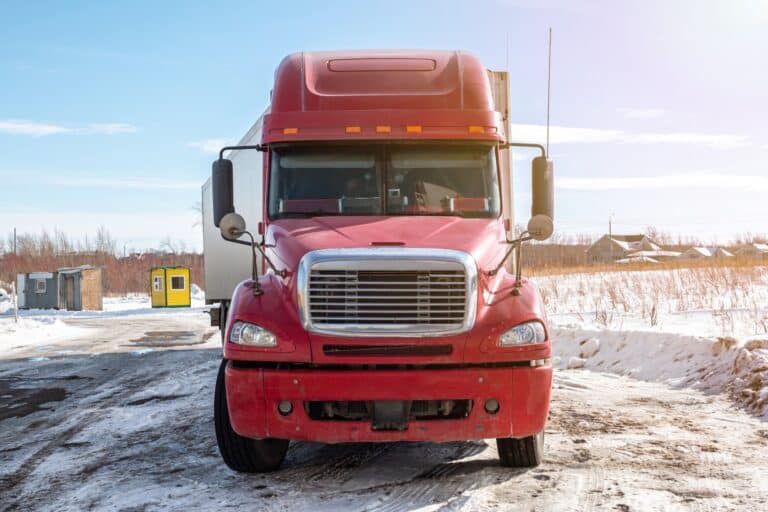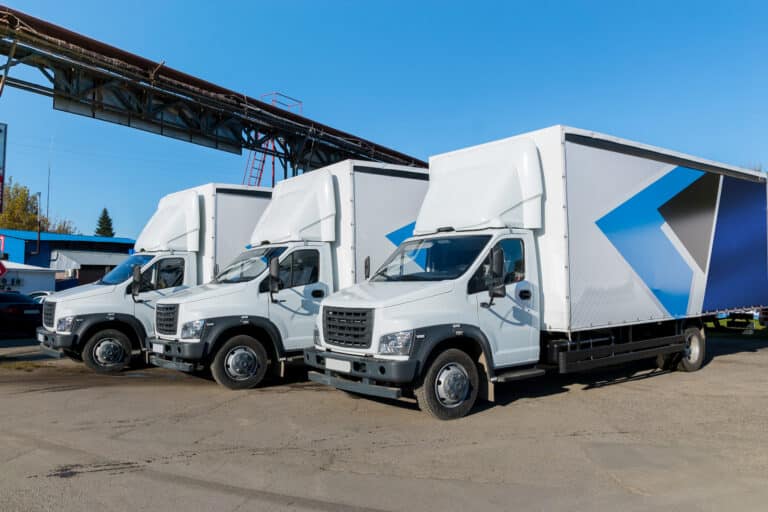Your electronic logging device (ELD) is as essential to your daily operations as your truck itself. The right ELD phone app can make your life easier on the road, while the wrong one can cause issues during DOT inspections and waste precious driving time. This guide will help you understand what makes a good electronic logbook and how to choose one that works as hard as you do.
What Is an ELD Phone App?

Think of an ELD app as the control center for your electronic logs. It’s the piece of software on your phone or tablet that connects to your truck’s ELD hardware to track your hours of service. While the hardware device plugs into your engine to record driving time automatically, the app is where you’ll manage your logs, complete DVIRs, and handle DOT inspections.
Your ELD app needs to do three main things reliably:
- Connect to your truck’s ELD hardware to record driving time.
- Let you update duty status and add notes to your logs.
- Display your HOS information clearly during inspections.
The app works together with the device that’s hardwired to your truck’s diagnostic port. When you’re driving, the hardware monitors your engine data and movement, while the app displays your hours and lets you manage your logs. This two-part system is required by the FMCSA to ensure accurate recording of your driving time.
Is a smart phone ELD app DOT compliant? The answer is no – a standalone app won’t meet FMCSA requirements. You need both pieces working together to stay compliant. The hardware records your driving time automatically, which is a key requirement that apps alone can’t fulfill.
Do you have any questions? Talk to ELD Advisor: 650-405-3372 or Request Callback
Key Features of a Reliable ELD App
When you’re looking at elog apps, certain features can make or break your daily experience. A good app should feel like a helpful co-pilot, not another hassle to deal with on the road. Essential features your ELD app needs to have include:
- Quick Bluetooth or USB connection to your ELD hardware.
- Automatic driving status updates when your truck moves.
- Clear display of remaining drive time and HOS limits.
- Simple DVIR reporting that takes minutes, not hours.
- Easy access to logs during DOT inspections.
- Offline mode that keeps working when cell service is spotty.
- Fast tech support when you need help on the road.
The most important feature is reliability. Your app should connect quickly when you start your day and stay connected throughout your drive. Look for apps that reconnect automatically if the connection drops, rather than requiring you to pull over and restart the app.
During DOT inspections, you need to access your logs quickly and show them clearly to the inspector. Good apps have a specific “inspection mode” that displays your logs in the required format with just a couple of taps. This saves time and helps you get back on the road faster.
Remember, the best logbook app is one you barely notice because it just works. It should feel natural to use and shouldn’t require you to be a tech expert to handle basic tasks. If you’re spending more than a few minutes dealing with your ELD app each day, something’s wrong.

How To Evaluate Smart Phone ELD Apps: Factors To Consider
Every ELD provider claims their logbook is the best, but real driver experiences tell a different story. When you’re comparing apps, focus on what matters during those long hours on the road and stressful DOT inspections.
Device compatibility should be your first consideration. Many drivers prefer using their own phones or tablets, so verify the app works with your preferred device. While providers like HOS247 offer flexibility with both Android and iOS options, others restrict you to specific tablets. Think about your backup plan too – you’ll want the ability to quickly switch to another device if yours breaks without losing access to your logs.
When evaluating ELD apps, consider these critical factors:
- Device flexibility. The app should work on multiple device types and operating systems, allowing you to switch devices easily if your primary phone or tablet fails.
- Offline capability. Your ELD must keep recording when cell service drops and sync automatically when connection returns, ensuring no gaps in your logs during rural routes.
- Support availability. Look for providers offering accessible support with staff who understand trucking regulations and can help during critical situations.
- Compatibility options. The best apps offer Android and iOS versions to accommodate drivers’ preferences.
- Training resources. Quality providers offer comprehensive training materials and onboarding support to get you up and running quickly.

Common Issues with Subpar ELD Phone Apps
You don’t want to discover problems with your logbook app during a DOT inspection or when you’re trying to make your delivery window. Understanding common issues helps you avoid choosing the wrong provider.
The most frequent complaints from drivers center around these key problems:
- Connection reliability. Frequent disconnections between your app and ELD hardware force unnecessary stops and create dangerous gaps in your HOS records.
- Hidden fee structure. Basic features often come with unexpected charges, such as fees for DVIR forms or accessing your own logs.
- Technical support quality. Many providers offer limited weekend support or use offshore teams unfamiliar with DOT regulations and real trucking scenarios.
- Software updates. Some providers charge extra for mandatory compliance updates or fail to maintain their systems with current FMCSA regulations.
Testing becomes crucial before committing to any electronic logging system. Use trial periods to thoroughly evaluate the app in real-world conditions. Start with your pre-trip inspection and run through a full day’s activities, including duty status changes and simulated inspections. Pay special attention to how the system handles common challenges like detention time and team driving switches.
Remember that switching providers creates extra paperwork and compliance risks. Investing time in selecting the right ELD app for phone from the start saves headaches down the road. Ask providers about their most common support calls and how they handle various roadside scenarios. A quality provider will be upfront about potential challenges and have clear solutions ready.
The Role of ELD Apps in Fleet Management
Your ELD app does more than just track hours of service – it’s becoming a central tool for efficient fleet operations. Physical operations leaders are increasingly relying on ELD systems to make data-driven decisions that affect both drivers and the bottom line.
Fleet managers now use ELD features to monitor real-time data that directly impacts your day, such as:
- Load optimization. Smart dispatching systems use your HOS data to match you with loads that fit your available drive time, reducing stress about making delivery windows.
- Route efficiency. Real-time GPS tracking helps dispatch guide you around traffic delays and construction, saving valuable drive time when minutes count.
- Maintenance tracking. Automatic fault code monitoring can alert you to potential issues before they become roadside emergencies.
- Fuel performance. Advanced tracking helps identify the most efficient routes and driving patterns, leading to better fuel economy and higher earnings.
While some drivers worry about increased monitoring, the data shows that well-implemented ELD systems actually reduce driver stress. According to fleet surveys, a majority of drivers report higher job satisfaction when using reliable electronic logbooks that help prevent HOS violations and provide clear documentation for detention time.
Popular ELD Phone Apps
The ELD market has evolved significantly since the mandate took effect. Today’s leading apps offer features that go well beyond basic compliance. Understanding what makes each provider unique helps you make an informed choice for your operation. Here’s a list of major providers and their app ratings:
| RANK | ELD PROVIDER | iOS APPSTORE | ANDROID PLAYSTORE |
|---|---|---|---|
| 1 | |||
| 2 | Motive | ||
| 3 | JJ Keller | ||
| 4 | BigRoad | ||
| 5 | Garmin | ||
| 6 | Rand McNally | ||
| 7 | |||
| 8 | Geotab | ||
| 9 | |||
| 10 | Transflo | ||
| 11 | PeopleNet | ||
| 12 | Verizon |
Reliability varies among providers. Focus on finding a provider that offers quality hardware, intuitive software, and responsive support – the three factors that most affect your daily experience.
The Future of ELD Apps: Trends to Watch
ELD technology is changing rapidly, bringing new features that make your life easier on the road. According to recent research, a majority of fleet leaders want to use AI to gain better visibility across their operations. This push for smarter technology is already changing how ELD apps work.
Next-generation elog apps are focusing on these key developments:
- Voice commands. Hands-free operation is becoming standard, letting you update your duty status and complete DVIRs safely while staying focused on the road.
- Smart load matching. AI systems now analyze your HOS data and location to automatically suggest loads that fit your available drive time and preferred routes.
- Fatigue detection. Advanced sensors and AI algorithms monitor driving patterns and behavior to detect signs of fatigue, providing early warnings to help prevent accidents and ensure driver safety.
- Weather integration. Real-time weather data combined with your route planning helps you avoid dangerous conditions and plan breaks around severe weather.
These changes aren’t just about adding fancy features. They’re about making your job easier and safer. For example, new AI systems can detect when you’re approaching your drive time limit and automatically start looking for safe parking options along your route.
Why Truckers Choose HOS247
When it comes to real-world performance, HOS247 stands out by focusing on what matters most to drivers. Their understanding of daily trucking challenges shows in both their technology and support approach.
Key benefits that drivers appreciate include:
- Reliable connections. The HOS247 ELD app provides a stable connectivity through Bluetooth for fewer disruptions in areas with poor cell coverage. This allows drivers to maintain compliant logs without needing to stop for reconnections.
- User-friendly interface. The HOS247 app is designed with drivers in mind, featuring an intuitive layout without unnecessary complications. The app is compatible with both Android and iOS, so drivers can use their preferred devices.
- Multilingual support. HOS247 offers live technical support in English, Spanish, Russian, and Polish, making it easy for drivers to reach assistance in their preferred language. Our reps are informed about HOS rules and possible issues to help troubleshoot quickly.
- No-contract plans. Truckers appreciate the flexibility of HOS247’s no-contract subscription plans. Drivers and fleets can choose monthly or yearly plans, and scale services as their needs evolve without being locked into long-term commitments.
- Hardware warranty. Every HOS247 device comes with a one-year quality warranty: if the device fails within the first year, we will replace them for free.
- Callback policy. Understanding the realities of trucking life, HOS247’s callback policy ensures that if a call to technical support drops, our team will call back immediately. This eliminates waiting in queues and reduces stress during critical moments.
- Additional features for operational efficiency. Beyond basic compliance, HOS247 offers features such as real-time GPS tracking, IFTA mileage calculations, and vehicle maintenance tools. These extras streamline fleet management, providing value that extends beyond the cab.
With its quality features and driver-first approach, HOS247 stands out as a trusted partner for trucking professionals.

Tips for Switching to a ELD
Changing ELD providers requires careful planning to avoid compliance gaps and logbook issues. From analyzing fleet tracking data, we know that switching providers typically takes 2-3 weeks for a smooth transition. The key is maintaining accurate records throughout the change.
Smart drivers follow these proven transition steps:
- Data backup. Save at least six months of logs before switching systems – this coverage protects you during roadside inspections and DOT audits.
- Trial testing. Run your new ELD system alongside your current one for at least a week to ensure everything works correctly with your specific truck.
- Training time. Give yourself enough practice time with the new system before relying on it exclusively, especially for inspection mode access.
- Support verification. Test the provider’s support responsiveness during odd hours when you’re most likely to need help.
Drivers who spend time testing their new system before fully switching experience fewer compliance issues during the transition. This preparation pays off during your first roadside inspection with the new system.
Conclusion
Your ELD app needs to work as reliably as you do. With the right system, electronic logs become a helpful tool rather than a daily frustration. Based on current GPS tracking data analysis, the best electronic logbooks maintain connectivity while providing clear, easy-to-use interfaces.
When making your final decision, start by talking to other drivers using the system – their real-world feedback matters more than promotional materials. Get a clear breakdown of all fees, including any charges for features you’ll need daily. This transparency helps avoid surprise costs down the road.

Support quality should be a major factor in your choice. Verify support availability during your typical driving hours, not just during business hours. A provider that offers efficient support with knowledgeable staff shows they understand the realities of trucking life.
Look for a provider that regularly updates their system to stay current with changing FMCSA requirements. The ELD mandate continues to evolve, and your provider should keep pace with these changes without charging extra for compliance updates.
Your ELD app is more than just a compliance tool – it’s your daily partner on the road. Taking time to choose the right system now saves countless hours of frustration later. Whether you choose HOS247 or another provider, focus on finding a solution that makes your job easier, not harder.

As an expert in B2B and B2C sales, I’ve dedicated myself to perfecting sales processes and client retention strategies in the logistics and trucking industry. I have significantly contributed to the expansion of the ELD service, catering to retail and wholesale clients in need of HOS247 ELD solutions. My unwavering commitment to implementing state-of-the-art sales techniques and technologies ensures the continuous growth and success of businesses I work with.












The Logbook App for iPhone to Rely On Electronic logging devices are critical for drivers and carriers that operate under FMCSA hours of service rules. The challenge is finding the right ELD when there are so many on the market.

Trucking businesses need their fleet to safely transport products to their customers. It can be challenging to supervise the individual operations of each truck. Fleet managers often rely on calls to contact drivers or on second hand information to stay

As a trucker, you know that electronic logging devices (ELDs) are more than just another gadget in your cab – they’re your digital co-pilot for staying compliant and running smooth operations. Whether you’re shopping for your first electronic logbook or